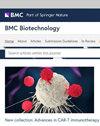Extraction and analysis of high-quality chloroplast DNA with reduced nuclear DNA for medicinal plants
IF 3.5
3区 生物学
Q2 BIOTECHNOLOGY & APPLIED MICROBIOLOGY
引用次数: 0
Abstract
Obtaining high-quality chloroplast genome sequences requires chloroplast DNA (cpDNA) samples that meet the sequencing requirements. The quality of extracted cpDNA directly impacts the efficiency and accuracy of sequencing analysis. Currently, there are no reported methods for extracting cpDNA from Erigeron breviscapus. Therefore, we developed a suitable method for extracting cpDNA from E. breviscapus and further verified its applicability to other medicinal plants. We conducted a comparative analysis of chloroplast isolation and cpDNA extraction using modified high-salt low-pH method, the high-salt method, and the NaOH low-salt method, respectively. Subsequently, the number of cpDNA copies relative to the nuclear DNA (nDNA ) was quantified via qPCR. As anticipated, chloroplasts isolated from E. breviscapus using the modified high-salt low-pH method exhibited intact structures with minimal cell debris. Moreover, the concentration, purity, and quality of E. breviscapus cpDNA extracted through this method surpassed those obtained from the other two methods. Furthermore, qPCR analysis confirmed that the modified high-salt low-pH method effectively minimized nDNA contamination in the extracted cpDNA. We then applied the developed modified high-salt low-pH method to other medicinal plant species, including Mentha haplocalyx, Taraxacum mongolicum, and Portulaca oleracea. The resultant effect on chloroplast isolation and cpDNA extraction further validated the generalizability and efficacy of this method across different plant species. The modified high-salt low-pH method represents a reliable approach for obtaining high-quality cpDNA from E. breviscapus. Its universal applicability establishes a solid foundation for chloroplast genome sequencing and analysis of this species. Moreover, it serves as a benchmark for developing similar methods to extract chloroplast genomes from other medicinal plants.提取和分析药用植物的高质量叶绿体 DNA 和还原核 DNA
获得高质量的叶绿体基因组序列需要符合测序要求的叶绿体 DNA(cpDNA)样本。提取的 cpDNA 的质量直接影响测序分析的效率和准确性。目前,还没有从鲂鱼中提取 cpDNA 的方法。因此,我们开发了一种合适的方法来提取牛膝的 cpDNA,并进一步验证了该方法对其他药用植物的适用性。我们分别采用改良高盐低pH法、高盐法和NaOH低盐法对叶绿体分离和cpDNA提取进行了比较分析。随后,通过 qPCR 对 cpDNA 相对于核 DNA(nDNA)的拷贝数进行了量化。正如预期的那样,使用改良的高盐低 PH 法从 E. breviscapus 分离出来的叶绿体结构完整,细胞碎片极少。此外,用这种方法提取的 E. breviscapus cpDNA 的浓度、纯度和质量都超过了其他两种方法。此外,qPCR 分析证实,改良的高盐低 PH 法有效地减少了提取的 cpDNA 中的 nDNA 污染。随后,我们将所开发的改良高盐低pH法应用于其他药用植物物种,包括薄荷(Mentha haplocalyx)、蒲公英(Taraxacum mongolicum)和马齿苋(Portulaca oleracea)。结果对叶绿体分离和 cpDNA 提取的影响进一步验证了该方法在不同植物物种中的通用性和有效性。改良的高盐低pH法是一种可靠的方法,可从鲂鱼中获得高质量的 cpDNA。它的普遍适用性为该物种的叶绿体基因组测序和分析奠定了坚实的基础。此外,它还是开发类似方法以提取其他药用植物叶绿体基因组的基准。
本文章由计算机程序翻译,如有差异,请以英文原文为准。
求助全文
约1分钟内获得全文
求助全文
来源期刊

BMC Biotechnology
工程技术-生物工程与应用微生物
CiteScore
6.60
自引率
0.00%
发文量
34
审稿时长
2 months
期刊介绍:
BMC Biotechnology is an open access, peer-reviewed journal that considers articles on the manipulation of biological macromolecules or organisms for use in experimental procedures, cellular and tissue engineering or in the pharmaceutical, agricultural biotechnology and allied industries.
 求助内容:
求助内容: 应助结果提醒方式:
应助结果提醒方式:


